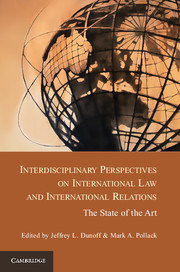 Interdisciplinary Perspectives on International Law and International Relations
Interdisciplinary Perspectives on International Law and International Relations Book contents
- Frontmatter
- Contents
- Contributors
- Acknowledgments
- Part I Introduction: Setting the Stage
- Part II Theorizing International Law
- Part III Making International Law
- Part IV The Interpretation and Application of International Law
- Part V Enforcement, Compliance, and Effectiveness
- Conclusions
- 25 International Law and International Relations Theory
- 26 Reviewing Two Decades of IL/IR Scholarship
- Index
- References
26 - Reviewing Two Decades of IL/IR Scholarship
What We've Learned, What's Next
Published online by Cambridge University Press: 05 January 2013
- Frontmatter
- Contents
- Contributors
- Acknowledgments
- Part I Introduction: Setting the Stage
- Part II Theorizing International Law
- Part III Making International Law
- Part IV The Interpretation and Application of International Law
- Part V Enforcement, Compliance, and Effectiveness
- Conclusions
- 25 International Law and International Relations Theory
- 26 Reviewing Two Decades of IL/IR Scholarship
- Index
- References
Summary
After two decades, and twenty-five chapters, of international law and international relations (IL/IR) scholarship, where do we stand? More specifically, what are the value-added insights of IL/IR relative to the extant scholarship in IL and IR taken separately, what are the weaknesses or lacunae in the literature, and what productive research agenda lies ahead? In this concluding chapter, we begin to outline preliminary answers to these questions.
The chapter is organized in five parts. Following this introduction, the first three sections address the volume's core thematic issues, asking what IL/IR has taught us about the making, interpretation of, and compliance with international law. In each area, we demonstrate that IL/IR scholarship has generated substantial theoretical insight and empirical knowledge about international law. However, in each case, this same scholarship has exhibited blind spots and gaps that can, and should, be addressed in a new generation of IL/IR scholarship that draws in a more balanced way on insights and methods from both disciplines.
- Type
- Chapter
- Information
- Interdisciplinary Perspectives on International Law and International RelationsThe State of the Art, pp. 626 - 662Publisher: Cambridge University PressPrint publication year: 2012
References
- 4
- Cited by


